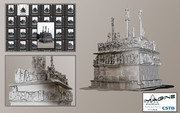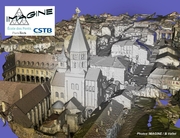Imagine: 3D modelling in a new era
The use of three-dimensional models of buildings or even entire districts has become essential for acoustic, thermal, lighting, air quality or vehicle traffic simulations. This is because everything forms part of the same framework of sustainable buildings and towers, regardless of the nature of the studies being done. Digital models are part of the daily routine of many CSTB teams. The only problem is that the creation of such models is expensive. It can take the teams of graphic designers responsible for them a long time to produce them (between a few weeks and a few months), and they sometimes need expensive equipment (laser telemeter), which is not always easy to use. "Finally, the concept of changing to the « computer vision » technique makes a lot of sense, says Jean-Philippe Pons, from CSTB. 3D photography in this branch of the data processing is now mature, and one of its uses can be to create digital models."
Unequalled precision
The basic principle used in photo modelling is exactly the same as stereoscopy. The only major difference is that instead of using just two photos, up to several hundred photos of the same building, the same zone or the same district can be taken from different points of view. The basic equipment required could not be simpler - a digital camera and software to « output » a 3D model without any human intervention. The result is much more precise than is possible using the classical method. Nothing is left aside when using this technique! A window sill or a crack in a facade, work can be done at a very fine resolution (never previously achieved) to the nearest pixel. "The data processing system used to produce this 3D model from digital photos was designed jointly by CSTB and the Marne-la-Vallée ENPC (École Nationale des Ponts et Chaussées), says Jean-Philippe Pons. We did it by creating Imagine*, a common ad hoc structure." Imagine also calls upon the skills of Bernard Vallet, a professional photographer who takes the pictures.
A tool for local communities, architects and design offices
Several full scale tests were used to validate the performance of the program produced by the parties involved at Imagine. The Aiguille du Midi in Chamonix-Mont-Blanc (Haute-Savoie), Cluny Abbey (Saône-et-Loire), the Tronoën Calvary (Finistère), etc.: the size of the sites or objects to be photographed is not important, precision is always achieved with interactivity as an extra. All facades can thus be seen, it is possible to "turn" around or even zoom into precise locations. "The service that we offer primarily concerns regional communities, architects, design offices, etc. continues Jean-Philippe Pons. CSTB has already carried out a study on lighting of the facade of a church in Germany." This simulation was interfaced with another lighting simulation software (Phanie) also developed by CSTB, to test different lighting configurations as a function of the position and nature of spotlights. Practical and efficient.
* Images, learning and geometry for digitisation of the environment.
On the highest step of the podium
The 3D modelling tool developed for Imagine was compared with the same type of software designed by other research teams. The objective was to carry out comparative tests to study the performance of each of these instruments as a function of objective and comparable criteria. The result of this international test bench was that Imagine's product was systematically put in first place, regardless of the criterion used.
Software to be widely distributed shortly?
CSTB is currently in contact with Autodesk® to study the feasibility of integrating a computer program developed by Imagine into a sequence of software packages produced by this editor. This would enable large-scale distribution of computer aided design (CAD) tools to all users.



